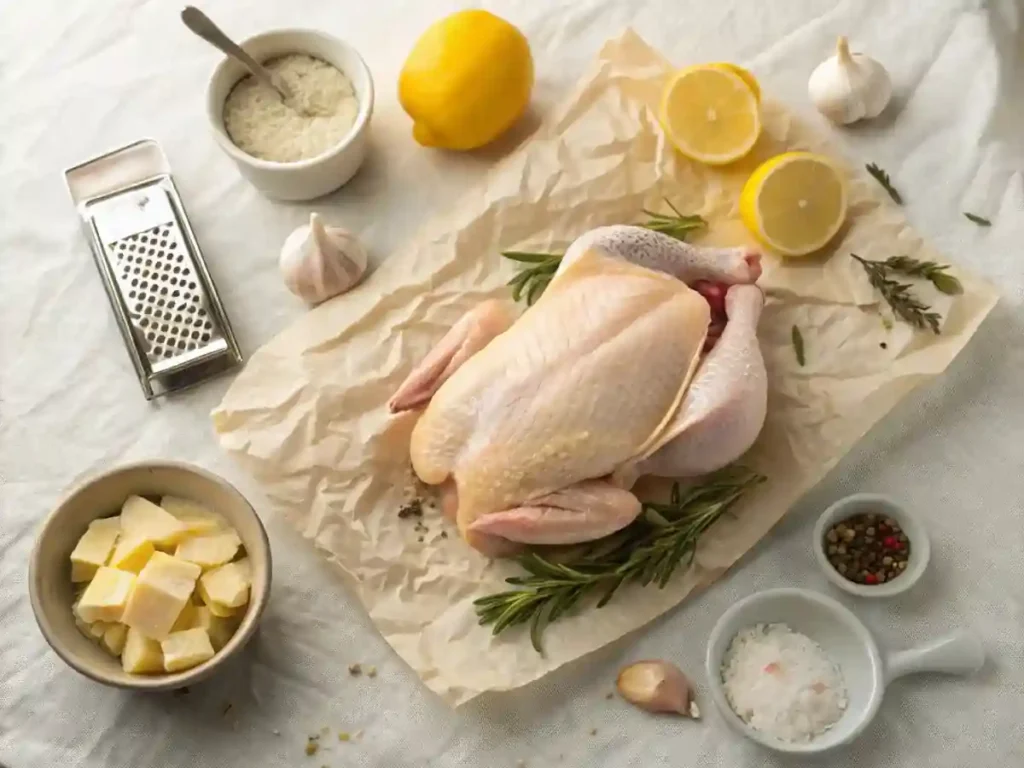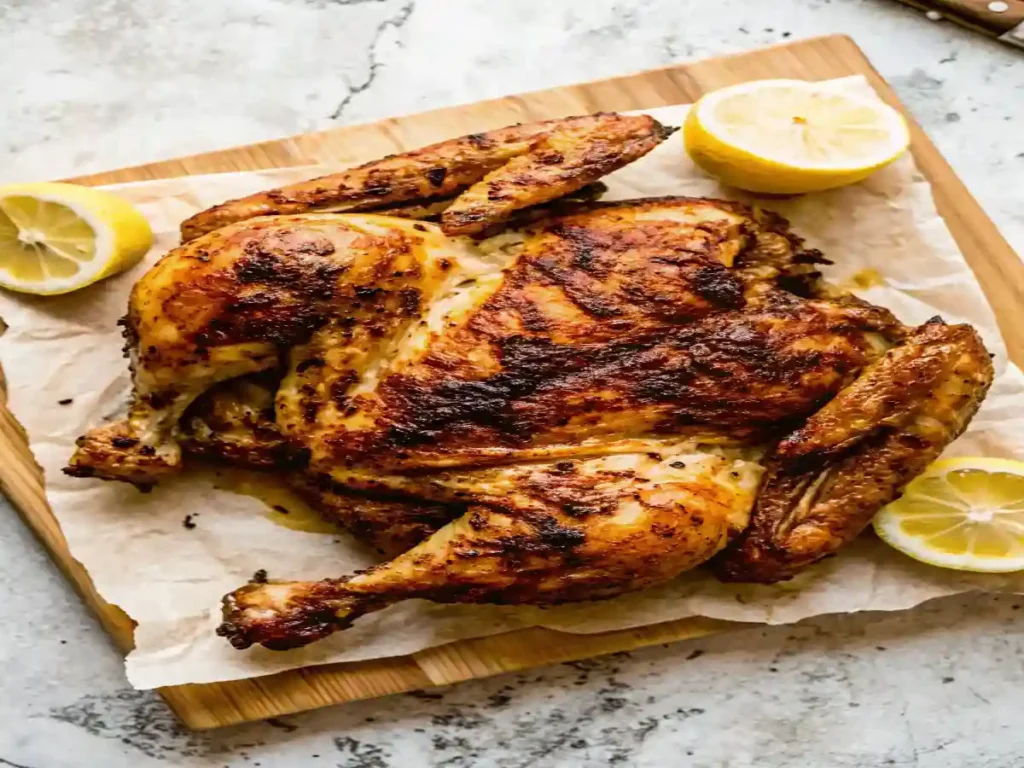What is the Downside of Spatchcock, Spatchcocking, or butterflying, is a trendy cooking technique where you cut out the backbone of a bird and flatten it out. It’s supposed to help cook the bird faster and more evenly. But, like with anything, there are some downsides. Not everything about spatchcocking is a win, and there are a few challenges that might make you think twice before trying it out.
Table of Contents
Key Takeaways
- Spatchcocking can be tricky, especially when removing the backbone.
- If not done right, spatchcocking can lead to uneven cooking.
- There’s a risk of overcooking certain parts of the bird.
- Traditional roasting might offer better flavor and texture for some.
- Handling raw poultry safely is crucial to avoid health risks.
Understanding the Basics of Spatchcocking
What is Spatchcocking?
Spatchcocking, also known as butterflying, is a cooking method where the backbone of a bird is removed, allowing it to lay flat. This technique speeds up cooking and ensures more even heat distribution, resulting in juicier meat and crispier skin. By increasing the surface area, it also allows for better seasoning and marinade absorption, enhancing the overall flavor profile.
Spatchcocking, or butterflying, is a cooking technique that allows poultry to cook faster and more evenly. For those new to this method, it’s important to understand why spatchcock chicken is so special and how it enhances the flavor and texture of your bird. The flattened shape not only ensures a perfectly crispy skin but also allows for better seasoning distribution.
How to Spatchcock a Chicken
Spatchcocking a chicken might seem daunting at first, but with the right steps, it becomes manageable:
- Prepare the Chicken: Place your chicken breast-side down on a sturdy cutting board.
- Remove the Backbone: Using sharp kitchen shears, cut along one side of the backbone from the tail to the neck. Repeat on the other side to remove the backbone completely.
- Flatten the Bird: Flip the chicken over and press down firmly on the breastbone until you hear a crack, allowing the bird to lay flat.
- Optional Step: For easier cooking, make small cuts at the joints between the drumsticks and thighs.
- Season and Cook: Pat the chicken dry, season it as desired, and cook it on a grill or in the oven.
Tools Needed for Spatchcocking
To spatchcock a chicken effectively, you’ll need the following tools:
- Kitchen Shears: Essential for cutting through the backbone.
- Cutting Board: A sturdy surface to work on.
- Paper Towels: To pat the chicken dry and clean up any juices.
Spatchcocking is a simple yet effective technique that transforms the way you cook poultry. By mastering it, you open up a world of culinary possibilities, from faster cooking times to enhanced flavors. Don’t be intimidated by the process—once you try it, you’ll wonder why you didn’t start sooner.
Challenges in Spatchcocking Poultry

Difficulty in Removing the Backbone
Spatchcocking sounds straightforward, but removing the backbone can be a real struggle. Kitchen shears are your best friend here, but even with them, it can feel like you’re wrestling the bird. You need to cut through bones and cartilage, which isn’t exactly a walk in the park. For those new to this, it might take a few tries to get it right, and even then, it’s not always pretty.
Risk of Uneven Cooking
One of the big promises of spatchcocking is even cooking, but it doesn’t always work out that way. If the bird isn’t laid out just right, parts of it might cook faster than others. This can be a headache, especially if you’re aiming for that perfect juicy meat. Using a meat thermometer can help you keep an eye on different parts of the bird, ensuring nothing’s over or underdone.
Potential for Overcooking
The flattened shape of a spatchcocked bird means it cooks faster, which is great unless you’re not paying attention. It’s easy to leave it in the oven too long, resulting in dry, overcooked meat. Keep an eye on it, and don’t rely solely on cooking times. Instead, check the internal temperature regularly with a meat thermometer to avoid disappointment.
Spatchcocking can be a game-changer for your poultry dishes, but it comes with its own set of challenges. Mastering these can make all the difference between a good meal and a great one.
One of the common challenges with spatchcocking is managing the cooking time to ensure the bird doesn’t overcook or dry out. Learning how to master spatchcock chicken cooking time can help you achieve the perfect balance between juicy meat and crispy skin. By monitoring the temperature and timing, you can take full advantage of this method.
Spatchcocking vs. Traditional Roasting
Time Efficiency Comparison
When it comes to cooking time, spatchcocking often wins the race. By flattening the bird, heat reaches all parts more evenly, cutting down the cooking time significantly. A spatchcocked chicken can roast in almost half the time it takes for a traditionally roasted one. This method can be a lifesaver, especially when you need to prepare a meal quickly without compromising on flavor.
Flavor Differences
Spatchcocking can enhance certain flavors, especially when it comes to getting that perfect crispy skin. With the entire bird exposed to direct heat, the skin crisps up beautifully, while the meat remains juicy. The flattened shape allows for more even seasoning, making each bite flavorful. However, some argue that traditional roasting allows for deeper flavors to develop, particularly with dark meat, as the longer cook time lets the juices mingle more.
Texture Variations
Texture is where personal preference really comes into play. A spatchcocked bird tends to have a more uniform texture, with the meat cooking evenly throughout. This means you get consistently tender bites from both the breast and the legs. In contrast, traditional roasting might give you a mix of textures, with the breast meat sometimes turning out drier than the succulent dark meat.
Choosing between spatchcocking and traditional roasting often boils down to what you value more: speed and even cooking, or the depth of flavor developed over a longer roasting period. Both methods have their merits, and it’s all about what suits your taste and time constraints.
Common Mistakes When Spatchcocking
Improper Use of Tools
Spatchcocking can be tricky if you’re not using the right tools. Sharp kitchen shears are your best friend here. Without them, removing the backbone becomes a wrestling match. Make sure your shears are sturdy and sharp to cut through those bones smoothly. Don’t attempt this with a flimsy knife; it’s a recipe for frustration and potential injury.
Inadequate Seasoning
Once you’ve flattened your bird, don’t skimp on the seasoning. Butter is a great base to start with. Rub it generously over the skin, and don’t forget to get some under the skin too. This step ensures your chicken stays juicy and flavorful. Add your favorite herbs and spices, but remember, balance is key. Too much of one thing can overpower the natural taste of the chicken.
Ignoring Cooking Times
Cooking a spatchcocked chicken is faster than a whole bird, but that doesn’t mean you can ignore the clock. Keep an eye on it to avoid overcooking. Use a meat thermometer to check the internal temperature, aiming for 165°F. This way, you’ll know it’s cooked through without drying out. Missing this step can lead to a dry meal, and nobody wants that.
Remember, spatchcocking is about making the cooking process easier and more efficient. But if you rush through it or skip steps, you might end up with a less-than-perfect dish. Take your time, and enjoy the process.
Safety Concerns with Spatchcocking
Handling Raw Poultry Safely
When spatchcocking, you’re dealing with raw poultry, which means you need to be extra careful to avoid any unwanted bacteria. Always start with a clean kitchen surface. Use a separate cutting board for your chicken and other foods to keep things tidy. Washing your hands before and after handling raw chicken is a must. It’s the simplest way to keep your kitchen safe.
Ensuring Proper Cooking Temperature
Cooking your spatchcocked chicken to the right temperature is key. Use a reliable meat thermometer to check the thickest part of the breast, steering clear of any bones which can mess with your reading. Aim for an oven temperature that ensures the chicken reaches 165°F internally. This not only cooks the chicken thoroughly but also keeps it juicy.
Avoiding Cross-Contamination
Cross-contamination is a big no-no in the kitchen. After using your knife or kitchen shears to spatchcock, wash them immediately with hot, soapy water. Don’t forget to clean any surfaces the raw chicken touched. Here’s a quick checklist to keep in mind:
- Use separate cutting boards for meat and veggies.
- Sanitize kitchen tools and surfaces after use.
- Store raw chicken away from other foods in the fridge.
Spatchcocking can make your chicken cook evenly and taste great, but it’s important to keep hygiene in mind. A clean kitchen is a happy kitchen, after all!
Handling raw poultry requires attention to safety, and this is especially important when spatchcocking. Knowing how to properly prepare and cook poultry is key to avoiding contamination. For more tips on this, read more about safely handling spatchcock chicken to ensure your kitchen stays safe while you create a delicious meal.
Spatchcocking for Different Types of Poultry

Adapting Techniques for Various Birds
Spatchcocking isn’t just for chickens. You can apply this technique to all sorts of birds, from small Cornish hens to big turkeys. Each type of bird has its quirks, so you need to tweak your method a bit. Smaller birds like quail or Cornish hens are more delicate, so you might need a gentler touch. For larger birds like turkeys, you’ll need stronger kitchen shears to handle the thicker bones. The key is to adjust your approach based on the bird’s size and structure.
Size Considerations
When you’re dealing with different sizes of poultry, the size of the bird really changes how you spatchcock. A small bird might only take a few minutes, while a turkey could take a bit longer. Here’s a quick look at what to expect:
| Bird Type | Approximate Weight | Estimated Spatchcocking Time |
|---|---|---|
| Quail | 4-6 ounces | 5-10 minutes |
| Cornish Hen | 1-2 pounds | 10-15 minutes |
| Chicken | 3-5 pounds | 15-20 minutes |
| Turkey | 10-20 pounds | 30-45 minutes |
Cooking Time Adjustments
Once you’ve got your bird spatchcocked, cooking times will vary based on size and type. Generally, spatchcocking helps the meat cook more evenly and faster. For example, a turkey might normally take hours, but spatchcocking can shave off a good chunk of that time. Here’s a rough guide:
- Quail: About 10-15 minutes at 400°F
- Cornish Hen: Roughly 25-30 minutes at 400°F
- Chicken: Around 35-45 minutes at 425°F
- Turkey: Approximately 75-90 minutes at 450°F
Remember, always check the internal temperature. The thickest part of the breast meat should hit 165°F to ensure it’s safe to eat.
Spatchcocking can make cooking poultry a breeze once you get the hang of it. Just keep in mind the bird’s size and adjust your tools and cooking times accordingly. You’ll be serving up perfectly cooked birds in no time!
Spatchcocking different types of poultry can require adjustments depending on the bird’s size and structure. For instance, tools like sharp kitchen shears are essential for removing the backbone with ease. To explore the most efficient tools for the job, discover the best tools for butterflying chickens and learn how to make the process seamless.
The Impact of Spatchcocking on Presentation
Aesthetic Appeal of Spatchcocked Birds
Spatchcocking transforms a whole bird into a flat, even surface, which can be quite striking on a platter. The technique not only enhances the bird’s appearance but also makes it easier to achieve that coveted crispy skin. By exposing more of the skin to direct heat, you create a golden, crunchy texture that is visually appealing.
Serving Challenges
While spatchcocking improves cooking time and texture, it can pose some serving challenges. The flattened shape might be awkward for those accustomed to carving a traditional roasted bird. However, with a bit of practice, serving a spatchcocked bird can become second nature.
Plating Techniques
When it comes to plating, spatchcocked birds offer a unique opportunity to showcase creativity. Arrange the bird with the skin side up to highlight the crispy surface. Consider garnishing with fresh herbs or citrus slices to add a pop of color. These little touches can elevate the presentation, making the dish as pleasing to the eye as it is to the palate.
Remember, presentation is just as important as taste. A beautifully arranged spatchcocked bird can impress guests and make any meal feel special.
Wrapping It Up: The Spatchcock Experience
So, there you have it. Spatchcocking isn’t just a fancy word to throw around at dinner parties; it’s a real game-changer in the kitchen. Sure, it might seem a bit intimidating at first, especially if you’re not used to handling raw poultry. But once you get the hang of it, you’ll wonder why you didn’t try it sooner.
The even cooking, the crispy skin, and the time saved are hard to beat. Just keep in mind, it’s not for everyone. If you’re squeamish about cutting up a bird or if you prefer the traditional roast, that’s totally fine. Cooking is all about what works for you. But if you’re up for a little adventure and want to impress your friends with a perfectly cooked chicken or turkey, give spatchcocking a shot. You might just find it’s your new favorite way to cook poultry.
Frequently Asked Questions
Is it worth it to spatchcock a chicken?
Yes, spatchcocking a chicken is absolutely worth it for many reasons. This technique ensures that the chicken cooks evenly because the bird lies flat on the cooking surface. It also reduces cooking time significantly, which is perfect for busy schedules. Additionally, the skin becomes crispier as it is exposed evenly to heat, resulting in a delicious texture that’s hard to achieve with a whole roasted chicken.
What are the downsides of spatchcocking?
One potential downside of spatchcocking is that it requires some butchering skills, as you need to remove the backbone with kitchen shears or a sharp knife. This can be intimidating for beginners. Additionally, if presentation is important, a spatchcocked bird may not look as visually appealing as a whole roasted bird for formal occasions. Lastly, while the meat is juicy, some argue it doesn’t retain as much of the traditional “stuffing” flavor since there’s no cavity to fill.
Does spatchcock turkey taste different?
Spatchcock turkey doesn’t taste drastically different in terms of flavor, but it does have a slightly improved texture and moisture retention. The even cooking prevents the breast meat from drying out while waiting for the thighs and legs to cook through. Plus, the crispy skin across the bird can enhance the overall flavor profile. The technique doesn’t affect the inherent taste but rather improves the cooking quality and experience.
What is the alternative to spatchcocking?
If spatchcocking isn’t for you, an alternative is trussing the bird. Trussing involves tying the legs and wings tightly against the body to ensure even cooking. Another option is breaking the bird down into separate pieces (like breasts, thighs, and drumsticks) to cook them individually. Lastly, roasting the bird whole without spatchcocking remains a classic and less labor-intensive choice, though it might result in uneven cooking times.
